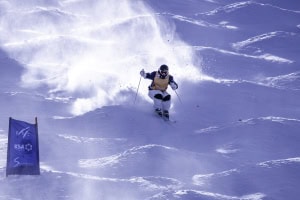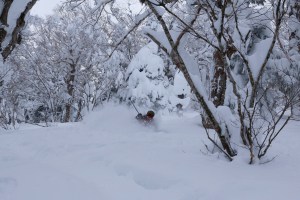Explainer – El Nino, What is it Anyway?

There’s no doubt that the weather in Australia has been a little wild of late – is it El Nino? Or is it just natural variation? Thredbo Resort, May 13, 2015 Image:: Thredbo
Mountainwatch | The Grasshopper
Everybody relax. Or panic. The Australian Bureau of Meteorology has officially decreed that an El Nino event has begun, and that it’s likely to continue until early next year. This is mountainwatch.com, and we know our readers are smarter than your average skier, so we want to provide you with a smarter than average background on what El Nino is and what, if anything, it means for snow cover in the Australian Alps.
We’re going to start with a good look at what exactly defines the “normal” state of the Pacific Ocean, so we can then understand what throws it out of equilibrium, and eventually into El Nino. Next up, we’ll cover why we even care about what’s going on thousands of miles away in the Pacific, and what effect it might have on Australian snow. And finally, we’ll recap on what that might mean for winter 2015.

You’re going to see images like this sea surface temperature forecast anomaly chart repeatedly in the next six months. Hopefully by the end of this article you’ll be making more sense of them. Source:: NOAA
It always starts with the sun.
When we talk about the atmospheric cycle I get uncomfortable saying that one thing causes another. Because they all cause each other. It’s a loop, or thousands of loops, not a straight line. But the only reason we have any weather at all is that the sun is continually throwing energy our way, preventing us from turning into a frozen lump. The sun’s rays hit the equator almost square on, and provide much more energy there than they do near the poles, where the sun is hitting at an oblique angle and spreads out over a wider area.

The portion of a sphere that sits at right angles to the sun’s rays absorbs the most energy. Source:: PETA
This differential heating makes the ocean and land at the equator heat up faster than the poles. The ocean and land then transfer heat to the atmosphere, which expands to higher altitudes than the freezing air at the poles – where more heat actually escapes into space than is received. Gravity then sets in and tries to force that air at the top of the atmosphere downhill, towards the poles. Meanwhile, a reverse flow is set up at the earth’s surface, with air flowing towards the equator to fill the gap left by the rising air. This sets up a circulation known as the Hadley cell.

Here’s how it starts. Source:: NOAA/JMA
One revolution per day
The spin of the earth, combined with gravity, also causes objects in motion to appear – to an earth based observer – to accelerate towards their left in the southern hemisphere. That means that in the southern hemisphere the southerly return flow back to the equator that we might intuitively expect – to replace all that rising air – is turned westwards to create the south-easterly trade winds.
These winds are almost always present in the central and eastern tropical Pacific – apart from brief periods or special occasions – and that constant blowing from east to west upon the surface of the Pacific Ocean causes warm surface water to pile up in the western Pacific. It actually sits higher, almost as if you were using a leaf blower on a bath tub. In the eastern Pacific, all of the water that gets blown westwards is replaced with colder water that wells up from below the surface. The physics is a little complicated, but given the shape of the continents and the spin of the earth this is the natural state of the Pacific Ocean, with warm water in the west and cooler water in the east.

Averaged over the whole year, this is the natural state of surface temperatures in the Pacific.
Even before we start with any talk of El Nino, we’ve got this big difference in temperature across the Pacific, maintained by those trade winds. We also need to note that the warmer water in the western Pacific encourages more thunderstorm activity and upward motion in the atmosphere near Indonesia, while the cooler water in the east leads to a denser air-mass and higher pressures. This all works to strengthen the trade winds further, in something called the Walker situation.

Normally, the best convection happens over the warmer water on the western side of the Pacific
But even this steady state isn’t steady. While the temperatures in the west stay fairly constant, in the east the temperatures bottom out in September and then peak in March/April – at which point the west to east gradient is the weakest. It is from this point in the year that the Pacific becomes sensitive to any disruption of the trade winds.
The MJO
One of the coolest discoveries with the advent of satellite data and computer modelling over the last 50 years has been the discovery and description of the Madden-Julian Oscillation. The physics is hard, but the MJO is basically a pulse of enhanced thunderstorm activity that travels along the equator, circling the earth every 30 to 60 days. It’s also one of the prime candidates for disrupting the trade winds. It works something like this: As this pulse of enhanced thunderstorms moves around the globe, it tends to suck surface winds towards itself. On its eastern edge the south-easterly trades get stronger, but on its western edge the south-easterlies weaken or may even turn westerly.

When it’s over the Indian Ocean the MJO looks something like this. Source::NOAA
The strength of the MJO ebbs and flows, from strong to weak, in a rather unpredictable cycle. When it moves into an active phase over the Pacific we get two key things happening. Firstly, on its western side we get a burst of westerlies that can disrupt the trade winds all by itself. Secondly, all of the extra thunderstorm activity makes tropical cyclones more likely to form, and on their equatorward-side these storms also tend to result in strong bursts of westerly winds – ie weaker or reversed trade winds.
Positive feedback
Once we get an initial weakening of the trade winds, then all of that warm water in the western Pacific starts to slosh back downhill towards the eastern Pacific. A pulse of warmer than normal water below the surface (known as a Kelvin wave) then spends the next three to four months travelling eastwards towards South America.
The physics is horrendous, but when it gets there, the Kelvin wave can disrupt the usual upwelling of cold water that keeps the eastern Pacific colder. So the surface of the eastern Pacific warms a little bit. This leads to slightly lower pressures, which weakens the trade winds a little bit further, which can lead to even more warm water sloshing eastwards, which leads to even more warming in the eastern Pacific, which weakens the trade-winds…. and so and so on. A simultaneous feedback occurs because all of that warm water sloshing eastwards moves the area of most intense thunderstorm activity from the western Pacific into the Central Pacific, reducing the area covered by the trade-winds.
When this occurs, we say that the ocean and atmosphere have “coupled” in a positive feedback mechanism, and before long we’ll be talking about an El Nino. Crucially, this also means Australia experiences more sinking motion in the atmosphere as it comes under the downward branch of the anomalous Walker Circulation.

The intense thunderstorm activity has moved eastwards, and Australia experiences more downward motion in the atmosphere. The orange areas reflect warmer sea surface temperatures.
The money shot
This change to the Walker Circulation is the key to understanding the most well-known effects of El Nino on Australia. More sinking air means higher pressures and less rising air. Higher pressures and less rising air means less cloud. Less cloud means less rainfall. Less rainfall means more drought.
With the stakes so high, picking the onset of El Nino and providing advance warning to stakeholders becomes very important. Scientists tend to use a few key indicators, such as anomalies in sea-surface temperatures, trade winds, cloudiness and mean sea level pressure to measure whether the atmosphere is in an El Nino phase.
In the images below you can see the big four anomalies that show up during El Nino, averaged over June to November for a dozen recent events.
• Top left: Sea surface temperatures warm in the eastern Pacific and cool in the west.
• Top right: Surface pressures rise in the west and fall in the east.
• Bottom left: Westerly wind anomalies are observed along the equator.
• Bottom right: Outgoing longwave radiation escaping from the earth’s surface is lower where there are more thunderstorms and clouds than normal (red area), but more heat escapes over Indonesia and north-east Australia where less cloudiness occurs.

Get used to acronyms like SST, MSLP, and OLR.
It’s important to remember that these are averages. Any particular El Nino might show strongly in one indicator but weakly in another. And herein lays one of the big challenges in educating folks about El Nino. We live in a black and white, yes or no world. The media often demand short explanations about this super complicated climate phenomenon, but some things take longer to explain.
If you stick three climate scientists in a room they’ll come up with seven different opinions on when any particular El Nino event started and stopped, or even whether it happened at all. Different climate agencies will concentrate on conditions in their part of the world. In fact, the American’s called this El Nino a month ago, when the Japanese were still talking about the end of the last El Nino, which nobody else thought was an El Nino. This isn’t a dig at the fine institutions in these countries. It is simply a way to illustrate that there’s no magic lamp that lights up to tell us we’re in an El Nino, and there’s always a subjective element to the thresholds chosen. The very question, “when did El Nino start?” is a bit like asking someone “at what moment did you fall in love?”
Between a drought and a soft snowy place
The other reason to feel sorry for the Bureau is that because every El Nino comes with its own quirks, we can see a wide range of impacts on Australia. You might have an El Nino event that is ticking all the boxes in the Pacific, but for unknown reasons the anomalous downward branch of the Walker Circulation over Australia will barely register, or will shift by a couple of thousand miles. Or an event might barely tip the scales in the Pacific, but Australia gets whacked with a high that won’t budge for months on end. Add in climate model forecasts that aren’t very accurate before May, and you’ve got a recipe for both surprise and disappointment.
This is the background to my seasonal outlook updates over the last couple of years. When we try to work out what sort of weather we will cop in the Australian Alps during winter, we’re faced with a bi-polar set of outcomes that bears almost no relation to the strength of the early indicators of El Nino in the Pacific.
If we’re unlucky, we get what I’ve dubbed the Classic El Nino. Six of these since 1976 have delivered far more high pressure activity than normal over and to the south-west of the Aussie Alps, which has stifled frontal activity and led to an average maximum snow depth at Spencers Creek of 137cm during these years (compared to a long term average of 176cm).

The classic, with its distinctive high pressure anomaly centred over Tasmania. This is bad news for snow.
On the other hand, a number of winters since 1972 have seen El Nino conditions in the Pacific, but with completely different results. I’ve been calling these “Wrong’uns” for the last couple of years, because they spin the other way. Instead of a big high pressure anomaly, during June to August we see a large area of lower pressure sitting just south of the continent. This means heaps of frontal activity. Heaps of cold air. Heaps of snow. Six events since 1972 have yielded 214cm on average. 4 of those years broke the 2 metre mark, and only one was below average.

The Wrong’un. These are good for snow. Very good.
Two horse race
We’re almost certain of an El Nino through this winter/spring. I’d say the odds are now greater than 95%, and it will probably be a strong one. That leaves us waiting to see what flavour of El Nino will show up. Classic or Wrong’un?
In my last seasonal update, the chances of a Wrong’un roared back into contention compared to March. But in the last couple of weeks climate models have started leaning back towards that Classic, and I think we’re now almost twice as likely to see a Classic than we are a Wrong’un. So for now I’m sticking to my 155cm forecast for peak snow depth at Spencers Creek, but hoping like heck that a Wrong’un comes through and blows my forecast to shreds with a couple of 1 metre storms.
We could talk longer, and discuss things such as interaction with the Indian Ocean, what happens during La Nina or what climate change might do to El Nino. Some of you might have wanted more maths or precision. But that’s all from the Grasshopper. Feel free to share some comments in the discussion below.






